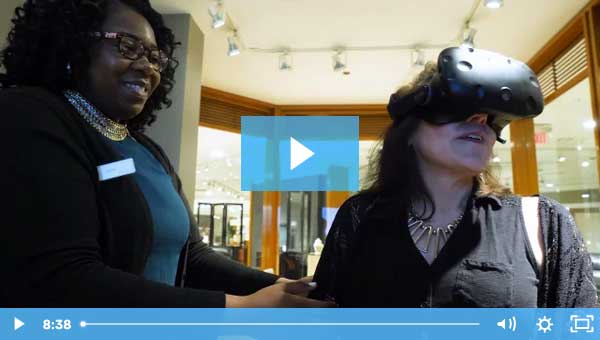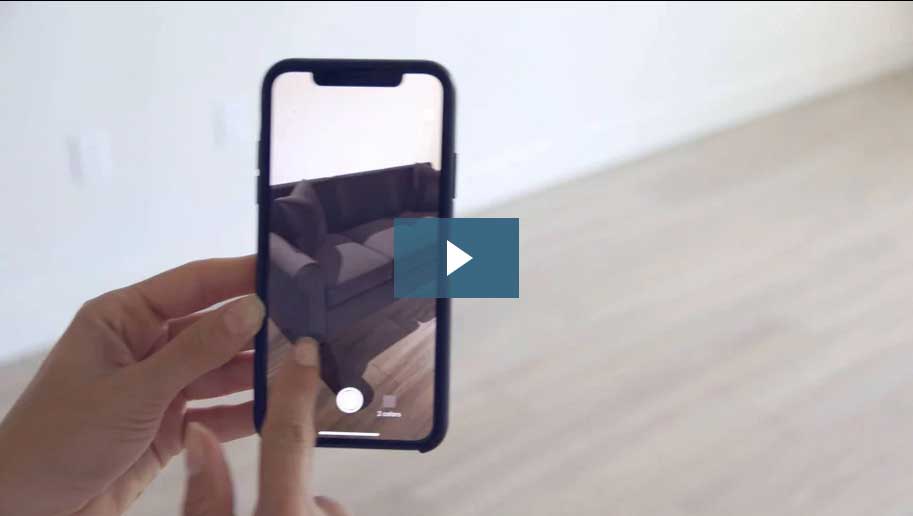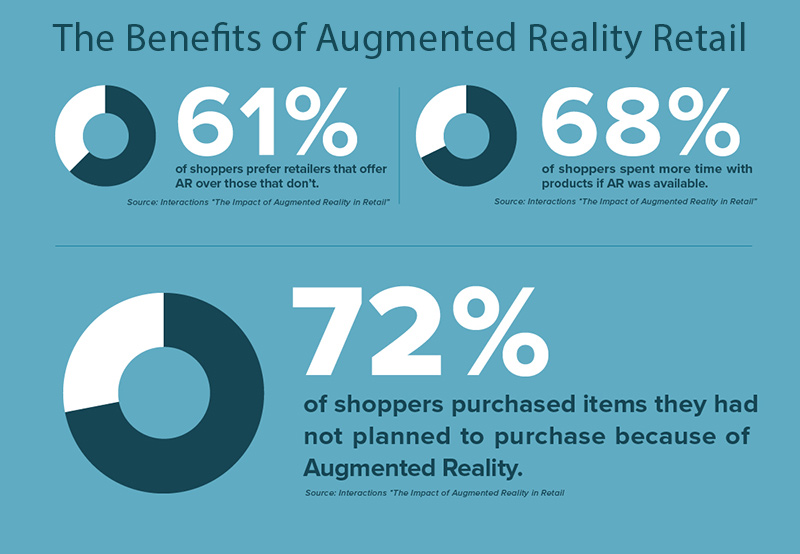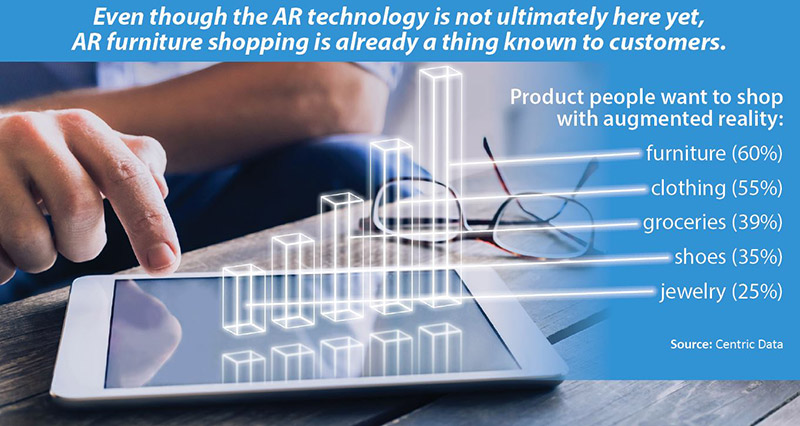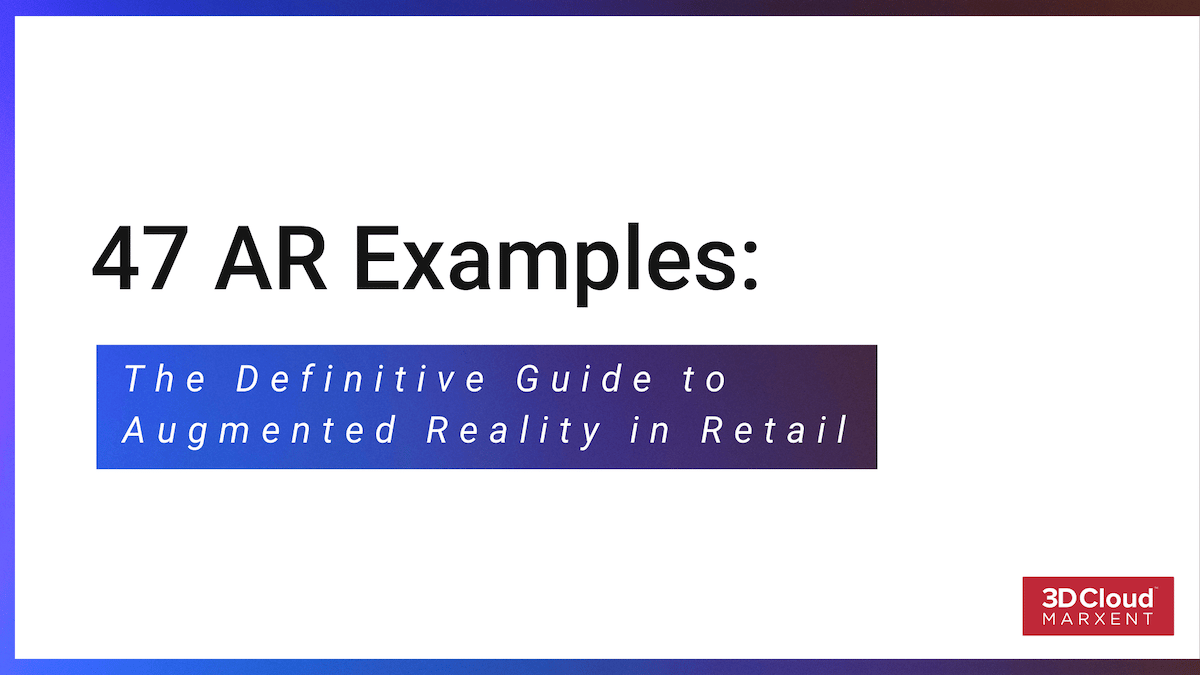
Video recap of 10 best Augmented Reality retail mobile apps of 2019
Looking for an overview of top AR apps in retail? Watch this quick video featuring the 10 best Augmented Reality retail apps of 2019.
Explore AR retail use cases
The best examples of “at home” AR retail experiences are in the furniture, DIY and beauty categories. These are designed to solve major consumer consideration crises, such as selecting a paint color or choosing a sectional, side table, lamp or coffee table that matches existing decor. Some of the challenges of putting 3D content into real world spaces include ensuring that the scale of the objects is sensical, accelerating tracking to reduce latency, realism, and color accuracy. Gap also offers a virtual fitting room app. Here’s our own countdown of the best examples in, Furniture AR, Beauty AR, Jewelry AR, Home Improvement AR.
Examples of AR Uses in Retail
Today’s consumer wants convenience, a way to preview and compare merchandise, and the luxury of personalization and customization. These examples demonstrate how AR delivers on all those needs, thanks to virtual try-on and try-out capabilities.
For personal items like apparel, footwear, accessories, beauty products, and eyeglasses, AR’s virtual try-on’s move people quickly from the consideration phase to making a buying decision. For big-ticket purchases like furniture, kitchen and bath fixtures, and cabinetry, buyers can see precisely how items will fit in their spaces and how a different color or texture will look. Walker Sands 2019 Future of Retail report reveals that 46% of respondents are more open to purchasing big-ticket items online than in 2018, and virtual try outs are a big part of that upward shift.
1. Omnichannel Immersion
Macy’s Virtual Reality furniture experience lets customers see a 2D floorplan in 3D in real-time. The application is easy to use and allows customers to pick from a vast selection of furniture and accessories to design a space they will enjoy.
2. Virtual Walkthroughs
Redfin Real Estate Interactive walkthrough home tours are available 24/7 and let buyers see each room, measure window heights, or any other dimensions within the home. It’s like being your own realtor. Shoppers can use the app to schedule a live tour and work with an agent. The residential real estate experience has experienced a revolution that makes it easier to decide on a home, even if its thousands of miles away.
3. Space Visualization and Design
Lowe’s product visualization tools help current and future customers carefully consider every aspect of large-ticket purchases. Lowe’s free Deck Designer tool gives its customers the freedom to create customized retreats using various materials, colors, shapes, and other details.
4. Color Matching
Customers can use preloaded color palettes in the Dulux Visualizer app to match an existing or preferred color from any object. The app samples a part of any object’s photo and shows the closest digital match from over 1,100 colors. The app can use a picture of a room to virtually paint it, providing a realistic visual of the finished project.
5. Bringing Clothes to Life
ASOS customers can see what the company’s clothes look like in motion with its Virtual Catwalk app. The user points the smartphone at a flat surface, clicks on the camera, then clicks the AR button on a product within the app, and voilà! A model appears wearing the selection in the user’s real-life environment.
6. In-Store Interactive Display
Kate Spade’s Make It Mine convertible handbag collection helps consumers customize their purse with scores of accessories. The experience combines how-to’s, video, detailed information, and enables purchases in-store or online.
7. Virtual Fitting Rooms
Lily’s pop-up store at a Shanghai subway station has two interactive screens that passengers can use to try on apparel. Users shoot a selfie, add their weight and height, and use a QR code to download their new image to their mobile device. The immersive experience offers target customers an ideal opportunity to find “just right” clothes, share with friends, and boost Lily’s brand.
8. Virtual Try-On
Customers can use the Warby Parker iOS app’s virtual try-on feature to see how frames will look on them. They select at a pair of eyeglass frames, open the camera, and see the frames fitted to the face. They can share a picture of the glasses, favorite them, or instantly buy them.
9. Brand Differentiation
Customers used a winter edition of Moosejaw’s X-Ray catalog app to “see-through” the clothing and reveal female and male models in their underwear. In this first AR retail app case study to prove ROI, the X-Ray interactive bonus raised sales from the Black Friday catalog, a stunning 37%.
10. Large Product Visualizations
BMW’s mobile app uses Google’s Tango AR technology to help automobile aficionados pick out the color, interior finishes, and wheel size. They can then virtually measure the car and place it into the prospective owner’s garage to test for fit. In addition to thrilling buyers, the solution spares valuable space on showroom floors.
11. Interactive Upselling and Cross-Selling
HappyReality is an entirely realistic shopping experience that feels like you are going through the aisles of a market. Use the app to place groceries in the cart, load your trunk, and drive home, all from a comfortable chair at home or in the office.
12. Build Customer Loyalty
Digital Box uses a webcam-connected monitor to capture video that consumers can use to interact virtually with Lego. The device generates 3D models of complete Lego builds to show kids the toy’s possibilities and encourage a purchase.
13. Brand Engagement
Starbucks frequently uses AR to solidify brand affinity. For this holiday promotion, patrons used Instagram, navigated to the Starbucks profile, and clicked on the effect gallery. After making their choice, they clicked “try it” and pointed their phone at a Starbucks holiday cup. The special effects appeared on the cup, and they could share the image on social media. Some Starbucks store locations featured special signage to remind patrons to try out the tech.
Examples of Augmented Reality by Furniture Retailers
Consumers are well aware that Augmented Reality is available for furniture shopping from various retailers, and over 60 percent of consumers want to shop for furniture using AR. The use case is similar across retailers of furniture, home decor, and small appliances. Below is a list of nine Augmented Reality apps for furniture, including Amazon’s AR View app which includes a lot of products, but mostly home decor rather than furniture.*
*Click the plus sign at the end of each grey bar to expand and see each AR use case.
1. Decor Matters: Design and Shop
Decor Matters mixes game design with serious home decorating tools that aim to keep shopping for new furniture and homegoods fast and easy. The application allows users to create DIY design projects — start from scratch, or converting existing design concepts from Pinterest, Houzz and Instagram — and provides “inspiration pages” to keep users motivated and trying new design options. Decor Matters AR feature allows users to preview their homegoods upgrades in their own space, allowing the shopper to judge fit and how well the new items with mesh with the existing design. Decor Matters includes millions of home furnishing options from renowned retailers like Target, Overstock, Crate & Barrel, Pier 1, West Elm, IKEA, Ashley, and more.
Decor Matters is a free download, though the app has in-app purchases to unlock “premium” features like expanded design inventory and personal decor.
2. Homestyler Interior Design
The Homestyler app lets users create their own design projects, and share them with family and friends to get feedback or to bask in their adulation. Users simply take a picture of their room, upload it to the Homestyler app and start designing. The app includes thousands of home furnishing options from the likes of IKEA, Target, Crate & Barrel and Pier 1, so users are never at a loss for products to try in their space. Homestyler then lets users check out products in their space through an Augmented Reality View. In addition to powerful design tools, Homestyler is also a hub for thousands of home improvement professionals, and the app offers regular design contests for users to show off their skills.
3. IKEA Place
The marketing around the IKEA Place ARKit app focused on the question “Will it fit?” The IKEA Place AR experience was developed with the particular problem of fit in mind — and to allow customers to avoid mistakes and returns by allowing for 3D at-home furniture preview.
In a pre-ARKit attempt at using Augmented Reality for furniture retail, IKEA used AR to help customers determine fit and preferences virtually interacting with the IKEA catalog. IKEA Place was first published back in 2011, but has been updated multiple times since the initial release.
4. Macy’s Augmented Reality Furniture App
Macy’s uses a 3D Cloud-based Augmented Reality API to make 3D AR furniture available in their native iOS app. Consumers shopping for furniture using the Macy’s native iOS app simply tap the “View In My Room” button on the product detail page of the furniture that they’re interested in visualizing. This launches the AR camera feature and allows them to place the 3D furniture into the context of their own homes.
5. Houzz – View In My Room 3D
In one app, Houzz customers can get ideas for their home renovations, shop for products, and find professionals in their area to do the work. In the company’s View In My Room 3D, users combine items and see how they will look together and in their rooms.
“It’s hard to shop for furniture” – that’s why Houzz developed View In My Room 3D. It’s not just about colors, but dimensions and size. View In My Room 3D works on iPhones and iPad and makes hundreds of thousands of products available through AR.
6. Bob’s Discount Furniture App with Augmented Reality
Similar to Macy’s, the Bob’s Discount Furniture app uses a 3D Cloud-based AR API in a native iOS shopping app. The app allows furniture shoppers to try out different combinations of furniture in their homes.
7. Magnolia Market – Shopify AR app
Chip and Joanna Gaines from HGTV have an app created by Shopify that allows people to see how accessories will look in their homes. The Magnolia Market app will detect a surface and users can place items on that surface.
8. American Furniture Warehouse – AFW Visualizer app
Similar to Macy’s and Bob’s, the American Furniture Warehouse AFW Visualizer app also uses a 3D Cloud-based AR API in a native iOS shopping app.
9. Pottery Barn – 3D Room View
This app claims it will take the guesswork out of furniture shopping. The 3D Room View app uses both AR and VR to design a space with Pottery Barn products.
10. Amazon AR View App
More home decor and small appliances than actual furniture, this at-home AR-enabled shopping experience is a part of Amazon’s native iOS app. Amazon’s AR View requires an iPhone 6S or newer running iOS 11. Download and open the main Amazon app then click on the camera next to the search bar .From the floating menu, choose “AR view.”
Examples of Augmented Reality in Beauty Industry
1. Mary Kay Mirror Me
The Mary Kay Mirror Me app lets users try on makeup using only their smartphone. Unlike other apps that require an uploaded photo, Mirror Me works with the camera on iOS and Android devices to let shoppers apply hundreds of Mary Kay products, shades and looks to their face in real time. No fuss, no muss, no cleanup required. Users can share their unique looks via email or social media platforms, and purchase their desired products directly from the app.
2. InkHunter
It’s hard to think of an industry that has to battle fears of buyer remorse more than tattoo parlors. Getting inked is permanent, which is why the InkHunter app is such a terrific use of Augmented Reality to solve a real-world problem. InkHunter allows users to preview any tattoo design on their body. The app includes a gallery of designs, but users can also use their own or pull images off the web. users can tweak the look of the tat with the included photo editor, then view their potential permanent addition from different angles using the AR view. InkHunter is available in both the Apple App Store and Google Play.
3. Sephora Virtual Artist
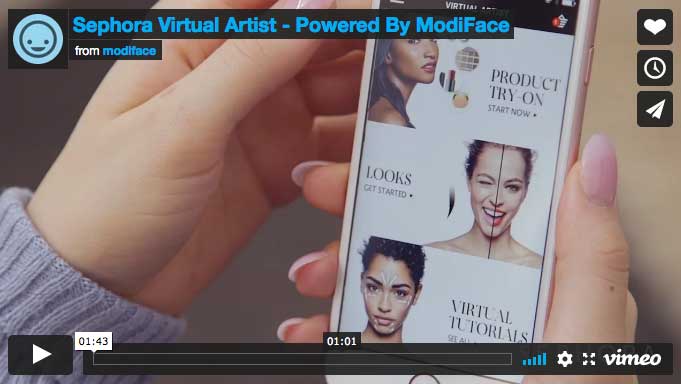
Sephora’s Virtual Artist is the Augmented Reality beauty app that started it all. Initially, the app allowed users to upload a selfie and “virtually try on” various products that could be purchased from Sephora. In 2018 it was updated to allow users to view themselves moving in real-time as their selected makeup application moves with them. According to Retail Dive, the update was backed by research showing a 22 percent drop in conversion rates when virtual products did not line up or appear correctly on the user’s face.
4. L’Oréal Paris
The L’Oreal Makeup Genius app lets customers try on makeup, blend different shades on their faces, and mix products to get the results they want. By scanning the product’s bar code in a store or selecting the product online, the app will apply it to the customer’s face using Augmented Reality. L’Oreal owns Modiface, the company behind Sephora’s Virtual Artist app.
5. Sally Hansen ManiMatch – Holition
A few years ago, Sally Hansen, a Coty company, attempted to make finding the perfect nail polish as easy as opening an app. With a quick scan of your hand, the app can unlock over 200 shades of Sally Hansen nail polish to try-on in real time. One of the features that they touted at the time was a color suggestion engine that provided personalized choices based on the shoppers skin tone. Shoppers could also buy shades directly from the app. There was definitely interest among beauty consumers, but Coty let the app fizzle. The app is still available in the App Store, but was last updated in 2016.
6. Wanna Nails – Manicure Try On
The same concept used by the Sally Hansen ManiMatch app was attempted by AR developer FaceCake around the same time. More recently, a company called WANNABY published the Wanna Nails app which has a 4.5-star rating and over 500 reviews. The app is enabled for purchases from Amazon.com.
Examples of Augmented Reality in Jewelry Shopping
1. Diamond Hedge
On average, shoppers spend around $6,000 on the purchase of a diamond engagement ring, according to PYMNTS.com. While purveyors of fine jewelry such as Blue Nile, Zales, James Allen, and Kay used photo-based Augmented Reality experience in early attempts to help shoppers visualize their options, Diamond Hedge took a slightly more ambitious approach. The Diamond Hedge app for iOS and Android uses the phone camera to track the base of the finger and place a ring on it real time. So you’re looking at an AR ring on your real hand in the real world, rather than on a photo of your hand.
2. Wanna Jewelry
Specializing in Augmented Reality retail try-on experiences, WANNABE takes on jewelry with their Wanna Rings AR app.
3. Bella Luce - Augmented Reality Jewelry Try On
Another one from the archives of 2011, the Bella Luce Augmented Reality jewelry try-on app was developed by the luxury AR experience company, Holition. The app relies on a piece of paper as a marker to place the ring on the shopper’s finger in real-time AR. Holition created a similar brand activation experience for watch try-on for Tissot around the same time.
4. Tissot - Augmented Reality Watch Try-On at Selfridges
In 2010, luxury watch company Tissot invested in an Augmented Reality brand activation that ran for a limited time at Selfridges London. Holition, the developer of the app, claims that the activation led to an 85% lift in sales during the course of the promotion. It was great for PR due to the experimental nature of the shopping experience. Similar to the Bella Luna experience (both experiences were pre-markerless AR) shoppers had to wear or hold a paper watch band with an AR marker to try on Tissot’s AR watches.
Examples of Augmented Reality in Home Improvement
1. Magicplan
Magicplan lets users create floor plans using the camera on their mobile device. The application automatically detects and captures windows and doors, measures ceiling heights, and draws a floor plan. Once the room is created (in as little as 30 seconds), Magicplan enables material and cost estimation, placement of 3D models, and virtual tours. Floorplans can be viewed in 3D and 2D views, exported in a variety of file formats (PDF, JPG, etc.), and are compatible with Excel, AutoCAD and design other programs. Magicplan is a free download, but there are in-app purchases and a subscription charge for the more advanced features.
2. Housecraft
Billed as “An AR Toybox for your home,” Housecraft makes it easy to plan for future homegoods purchases and upgrades. Housecraft uses Augmented Reality to let users place 3D models of furniture throughout their home (they just added hot tubs!), in the process determining whether the items fit and how they will go with the existing pieces. Housecraft also allows users to save room configurations for later viewing. The app is a free download from the iOS App Store or Google Play.
3. Build.com
The app lets people see how items like faucets and light fixtures will look in their home.
4. Lowe’s Home Improvement - Measured by Lowe's
The Measured app turns a phone into a digital tape measure and provides instant measurements.
5. Home Depot
The Project Color app and online Color Center allow customers to virtually try paint colors. The company’s store app allows furniture placement in an existing room.
6. Sherwin Williams
The Sherwin-Williams ColorSnap mobile app is focused on the problem of helping customers to narrow down their color choices. It allows people to match colors using photos or see how a color will look in a room. Benjamin Moore offers a similar experience, with a web-based AR tool that allows people to see how paint colors will appear. Customers can upload a photo from a computer, define areas, and select a paint color to see how it will look.
Augmented Reality Retail Apps for Fashion and Footwear
1. Wanna Kicks
Sneaker freaks love to try on new shoes, and the Wanna Kicks app is here to let them sort through — and drool over — a wide variety of new and classic sneaker designs. Wanna Kicks uses Augmented Reality visualization to enable shoppers to see how potential sneaker purchases will look on their feet. Users can check out their new look, then grab a video for sharing on social media. The app is currently available exclusively as a free download from the Apple App Store.
2. Crocs LiteRide AR
The Crocs LiteRide AR app is highly use-case specific, but points the way for other brands looking to make innovative use of 3D visualization in marketing and sales. In a quasi-throwback move, the Crocs LiteRide AR uses a shoebox as an AR tracker — remember those? (The app works with or without the marker.) A Crocs customer can point their smartphone camera at the box, which triggers visual overlays of information about the Crocs contained within. The Crocs LiteRide AR app was created specifically to hype the Crocs LiteRide product, which severely limits what a user can do with it — but the idea of having digital info encoded into a product’s packaging has many useful applications across industries and should become more common soon.
3. Gap – Gap Dressing Room AR App by Avametric
4. Nike SNKRS
Designed by a special office located in Manhattan called S23NYC (a reference to Michael Jordan’s number), the Nike SNKRS app is an experimental project that has been aimed at engaging with the quintessential sneaker collector, or what Fast Company refers to as “obsessed superfans.” The app uses a combination of exclusive promotions, geofencing and Augmented Reality to help fans unlock rare sneakers.
5. Lacoste
The international retailer’s app allowed people to virtually try on shoes to see how they would look on their own feet.
6. Converse – The Converse Sampler App
The Converse Sampler App shows how different styles of Converse shoes look on a customer’s feet. The shopper can snap a photo for sharing on social media.
7. Moosejaw
This provocative app called X-Ray allowed customers who were looking at a printed catalog to see images of what the models would look like in their underwear.
8. Airwalk – Invisible Pop Up Store by GoldRun
GoldRun founder Vivan Rosenthal was very early to the market with Augmented Reality solutions for retailers, specializing in a combination of AR and location-based marketing. To build brand awareness, back in 2010, the sneaker brand Airwalk created invisible pop-up stores in various locations in partnership with GoldRun. The app did millions in sales and the exclusive products sold out. In addition to Airwalk, Nike, AXE body spray and others created GoldRun AR real-world treasure hunt experiences (think of it as Pokemon GO for brands) between 2010 and 2013. In 2014, the company changed direction and its name (now it’s Snaps), and became a conversation cloud company.


